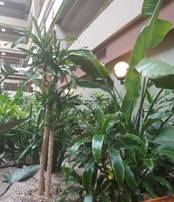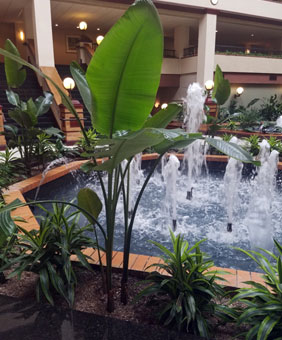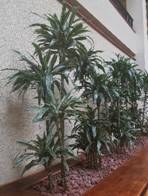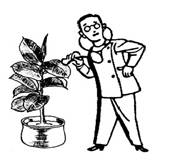Kentucky Pesticide Safety Education Program

Questions?
Contact
Dr. Ric Bessin
Dept. of Entomology
University of Kentucky
859-257-7456
rbessin@uky.edu
Interior Plantscape Pest Control

Living plants are commonly used indoors primarily for aesthetic purposes. Restaurants, hotels, shopping malls, and office buildings use plants to make the indoor environment more pleasing for customers and employees. To maintain healthy interior plants one must have an understanding of optimal growing conditions for the species of plants involved. These include proper light, temperature, humidity, soil moisture and pH. Providing these conditions becomes challenging when an interior landscape can contain many species of plants in a variety of environments.
Indoor plants are also susceptible to attack by many types of pests. In addition, plants often are under environmental stress due to less than optimal growing conditions. In interiorscapes, plants endure suboptimal light, water and temperature for sustained growth and may be exposed to excessive salts. These plants may also be exposed to human-induced stresses, such as having coffee, soda pop, or cleaning liquids poured on them. Under these stressful conditions plants are more susceptible to pests and less capable of recovering from an infection or infestation.
Treatment options in the interior plantscape are limited and indoor pest control is a highly sensitive issue. Control measures must be safe for humans and for the plants themselves. Pesticide risk can be minimized by selecting pesticides carefully, limiting applications, using lowest practical rates and correcting improper practices that contribute to the problem. Using many tactics or strategies to manage pests so that 1) an acceptable appearance and quality can be achieved, 2) management is economically feasible, and 3) minimal disruption to the environment occurs, is called integrated pest management (IPM).
The goal of IPM is to reduce the occurrence of plant problems and to maintain insect populations and disease problems at levels where aesthetic losses and economic losses are tolerable. Rarely is pest eradication a goal, as it is not possible to completely eliminate a pest or pathogen once it establishes. a successful IPM program includes all economically and environmentally sound practices that help prevent or reduce plant injury. Integrated pest management incorporates a wide range of pest controls such as resistant plant varieties, cultural practices, mechanical controls, biological controls and pesticide applications
The basic components of an IPM program include:
- Proper horticultural care of plants and minimization of plant stress.
- Regular monitoring and early detection of disorders.
- Proper diagnosis and identification of plant disorders.
- Determination of economic or aesthetic significance.
- Selection of management methods or actions.
- Evaluation of management methods through continued monitoring.
[return]
Monitoring and Detection
 Typically, a plantscape manager visits an interior landscape on a regularly scheduled basis. Monitoring for plant pests, diseases, and/or poor growing conditions should be an integral part of each visit. While watering, rotating, and cleaning, one should be alert to general plant health and identify early signs or symptoms of pest infestations and diseases. Early detection allows for management of pests or alteration of conditions before host plants suffer serious injury. In addition, low levels of pest infestation are typically easier to manage and the use of less toxic management strategies may still be an option. Washing foliage with a soap solution, pruning symptomatic tissue, or correcting poor site conditions may eliminate problems without the use of a pesticide.
Typically, a plantscape manager visits an interior landscape on a regularly scheduled basis. Monitoring for plant pests, diseases, and/or poor growing conditions should be an integral part of each visit. While watering, rotating, and cleaning, one should be alert to general plant health and identify early signs or symptoms of pest infestations and diseases. Early detection allows for management of pests or alteration of conditions before host plants suffer serious injury. In addition, low levels of pest infestation are typically easier to manage and the use of less toxic management strategies may still be an option. Washing foliage with a soap solution, pruning symptomatic tissue, or correcting poor site conditions may eliminate problems without the use of a pesticide.
Some insect species can be detected with the use of yellow or blue sticky cards. These cards have a sticky substance on the surface so that insects cannot escape. The cards are either hung in the plant canopy or attached to a stick inserted into the soil. Yellow cards are highly attractive to aphids, whiteflies and thrips, while blue cards are more specific for thrips. Both colors also will attract fungus gnats. Regular inspection of these cards will help to determine what insects are present and to show relative changes in numbers from one visit to the next. It is important to record the numbers and types of insects per card on each visit. Written records confirm whether problems are improving, getting worse or staying the same. Cards should be changed on a regular basis, when they become so heavily covered with insects that it is too difficult to count them, or after a pesticide treatment. Circle insects captured each week so they are not counted on the next visit.
Disease agents may be more difficult to monitor and detect, and disease symptoms are often confused with abiotic disorders. For example, most plant diseases are caused by microscopic organisms that cannot be seen with an unaided eye. Likewise, abiotic disorders often resemble disease symptoms. Monitoring of these types of problems includes close examination of plant tissue. Sample collection is often required so that diagnosis can be confirmed by a laboratory. Soil tests and leaf tissue analysis is an effective assessment for deficiencies and toxicities; this information is sometimes needed to better understand plant problems.
To keep monitoring and detection information uniform, develop a system to rank plant condition. If time allows, documenting healthy plant conditions provides a written record of an inspection. If a problem does occur, this background information will help in making a diagnosis. Record information useful for planning management strategies:
- Level of light (footcandles)
- Plant species
- Plant age and size
- Date of installation
- Size of container
- Type of soil or media
- Symptom details (incidence, severity)
- Signs of pests or disease
- Life stage of the pest
- Type and level of damage
- Date of detection, etc.
[return]
Diagnosis and Identification
When damage or poor plant health is detected, the interior plantscape manager must determine what cultural or environmental conditions, diseases, insects, mites, or human activity is responsible. Remember, there is often more than one damaging influence. Identify all conditions that may have stressed the plant, causing it to be more susceptible to the problem or pest observed. Below is a general guide to common symptoms and possible causes of indoor plant disorders.
-
Identify the plant
 Certain plant species are more prone to specific pest problems. For example, Ficus are susceptible to scales, Schefflera are susceptible to mealybugs, and palms are susceptible to spider mites. Become familiar with common pest, disease, and abiotic disorders; inspect the whole plant, especially the undersides of stems and twigs. If possible, carefully remove the damaged plant from its container to examine root and soil conditions. Inspecting the root environment is often difficult but necessary.
Certain plant species are more prone to specific pest problems. For example, Ficus are susceptible to scales, Schefflera are susceptible to mealybugs, and palms are susceptible to spider mites. Become familiar with common pest, disease, and abiotic disorders; inspect the whole plant, especially the undersides of stems and twigs. If possible, carefully remove the damaged plant from its container to examine root and soil conditions. Inspecting the root environment is often difficult but necessary. -
Clearly define the symptoms
Document where the symptoms occur on the plant. Examine the site to determine source or pattern (air flow, temperature change, canopy density). Determine whether symptoms are the same as the symptoms the client is concerned about.
-
Categorize the cause of the problem as biotic or abiotic
Biotic disorders are caused by insect or mite infestations or by a disease agent.
Abiotic disorders are caused by non-living agents such as improper light, temperature, humidity, water, media, pH, soluble salts, volatile gas, cleaning compounds, relocating, breakage, food/beverage wastes, watering with excessively cold water.
-
Evaluate the environment
An interior plantscape environment is generally favorable for pests and disease organisms when appropriate cultural and environmental conditions fail to provide stress-free plants.
Consider these factors of the macroclimate: Where are the heat or air-conditioning vents? Are there drafts from doorways? Are light levels adequate? Note temperature and humidity levels and the plant's proximity to windows. Ask the client about activities that may disturb the plant. Is the container being used as a receptacle for coffee, cigarette butts, or cleaning compounds?
[return]
Selection of Pest Management Methods
The pest management methods most appropriate for a specific circumstance will depend upon the biology of the pest and host plant, and the interior landscape situation. For every pest problem consider all available management tactics and evaluate the benefits and risks of each. Often the use of multiple tactics is more effective than use of a single tactic.
Choose methods that are:
- Practical in an indoor setting.
- Least toxic to nontarget organisms.
- Enhance natural controls and plant defenses.
- Likely to limit the pest permanently.
- Least hazardous for the applicator to handle.
Also, as a plant manager, consider the option of removing the plants to be treated from an interior landscape and temporarily relocating them outside or to a greenhouse. Relocating plants makes available a larger selection of products registered for use in those areas (including some that may not have been appropriate for use in the interior landscape setting.) Furthermore, the conditions in a greenhouse (light, temperature, and water) may be more conducive to the plant's recovery. Once the plant has been treated and the problem corrected, it can be replaced in its original interior landscape location.
[return]
IPM Evaluation
It is extremely important to evaluate the results of your pest management strategies. This can be done in several ways. Record pest counts or level of infection before and after treatment, comparative damage ratings, length of recovery time, etc. Sticky cards, as discussed under monitoring in this section, are helpful in evaluating the results of an insect management treatment. Keep written records of successes and failures, timing of treatment, and special conditions.
A General Diagnostic Guide for Indoor Plants with Symptoms and Possible Causes

Brown or scorched leaf tips
- Poor root health from overwatering, excessive soil dryness (especially between waterings), excessive fertilizer or other soluble salts in the soil or root rot disease.
- Specific nutrient toxicities such as fluoride, copper or boron.
- Low humidity.
- Pesticide or mechanical injury.
Leaf spots, blotches, blemishes, blisters, or scabby spots
- Intense light (sunburn) associated with a recent move of the plant or excessive soil dryness and wilting.
- Chilling injury (below 50°F).
- Chemical spray injury.
- Overwatering.
- Fungal or bacterial infections (not common unless plants have recently come from a field or greenhouse).
Older leaves yellow-green
- Insufficient fertilizer, especially nitrogen.
- Poor root health due to pot-bound growth, compacted soil, or poor drainage.
- Insufficient light.
- Senescence (natural aging process of individual leaves).
Newer leaves yellow-green
- Soil pH (acidity) imbalance.
- Trace element imbalance.
All leaves yellow-green
- Too much light or large changes in light intensity.
- Insufficient fertilization.
- High temperatures, especially when associated with dryness.
- Insect infestation or root rot disease.
Leaf drop
- Poor root health from overwatering, excessive dryness or excessive fertilizer or other soluble salts in the soil, compacted soil or pot-bound roots.
- Sudden change in light, temperature, or relative humidity.
- Root rot disease.
Wilting or drooping of foliage
- Poor root health from overwatering, excessive dryness or excessive fertilizer or other soluble salts in the soil, compacted soil, or a poorly drained container or root rot disease.
- A toxic chemical poured into the soil.
Roots brown in color, soft or rotted roots with tissue that can easily be "slipped off" leaving behind the string-like center tissues; roots massed at top or bottom of pot.
- Poor root health from overwatering, excessive dryness, excessive fertilizer or other soluble salts in the soil, compacted soil, or a poorly drained container.
- A toxic chemical poured into soil.
- Root rot disease.
Yellowed leaves with tiny speckling; leaves later bronzed and drying; webbing noted near growing points.
- Spider-mite infestation.
Leaves or stems covered with a sticky substance; mold growing on leaves; tiny brown or white objects seen on leaves or in crotches of branches; leaf drop or branch dieback; leaf or growing point distortion.
- Scale, aphid, whitefly or mealybug infestation.
Leaves emerging from buds small, thickened and brittle with margins curved downward; may resemble exposure to a phenoxy herbicide.
- Broad or cyclamen mite infestation.
Material in this chapter adapted from Michigan State University Extension Bulletin E-2308 Interiorscape Pest Management. A Training Manual for Commercial Pesticide Applicators. Julie Stachecki, Editor.
1) Indoor plants
- are often under environmental stress.
- are more susceptible to pest attack.
- may grow poorly because of suboptimal light or temperature conditions.
- contend with human-caused stresses.
- all of the above
3) The goal of an indoor IPM program is to eradicate pests that attack interior plantscapes.
4) Regular monitoring of plant health- should be followed by immediate use of pesticides at the first sign of a pest problem.
- is too invasive to maintain healthy plants.
- is not feasible in mixed plantings.
- allows for less toxic pest management before plants suffer serious injury.
5) Disease agents are more difficult to diagnose because
- abiotic disorders often resemble disease symptoms.
- samples cannot be gathered indoors.
- indoor plants are rarely exposed to disease.
6) Which of the following is not a pairing of "susceptible plant - common pest"?
7) Which of the following is not a factor to consider in evaluating the interior plantscape environment?
- Temperature and humidity levels
- Light levels
- Cigarette butts and trash in planters
- Proximity to curving walkways
- Location of heating vents
8) If pest infestation levels are low, which of the following is/are viable management options?
- Washing foliage with a soap solution
- Pruning
- Correcting poor site conditions
- Any of the above
- None of the above
9) Choosing the most appropriate pest management method(s) depends on the biology of the pest and host plant and the interior landscape situation.
10) Yellow sticky cards will attract
10) Blue sticky cards will attract
12) It is not necessary to evaluate pest management results as every situation will be unique.
website content by R. Bessin website designed by P.M. Dillon copyright © 2019 University of Kentucky Department of Entomology
University of Kentucky College of Agriculture |
S-225 Agricultural Science Center North, Lexington, KY 40546-0091 | 859.257.7450
An Equal Opportunity University |
Last modified
08/27/2019
